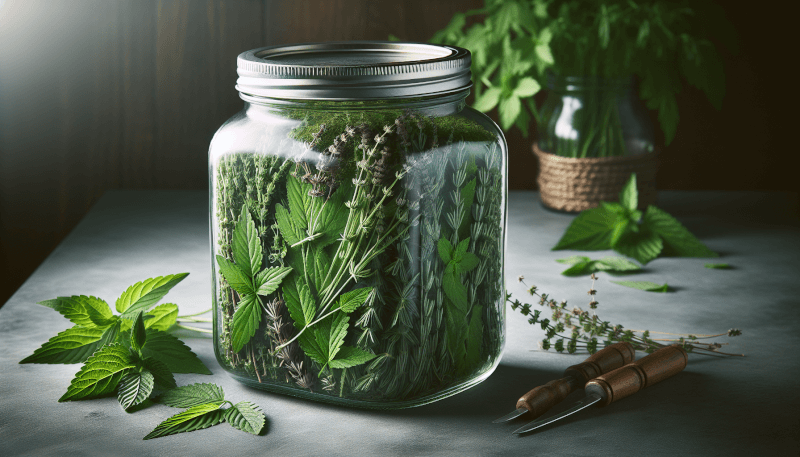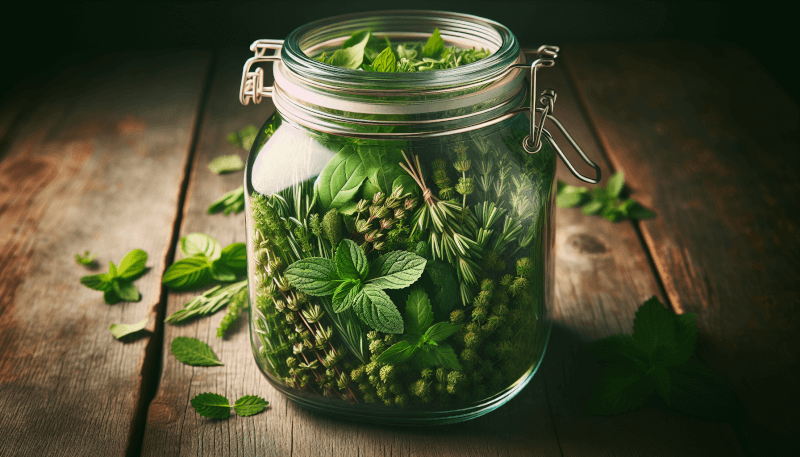Imagine having an abundant supply of fresh herbs at your fingertips all year round. With the right storage techniques, you can preserve the vibrant flavors and aromas of your favorite herbs for an extended period. In this article, you will discover practical tips on how to store fresh herbs for long term use, allowing you to elevate your culinary creations and enjoy the taste of garden-fresh herbs whenever you desire.

Choosing and Harvesting Fresh Herbs
Selecting the right herbs
When it comes to choosing fresh herbs, there are a few things to consider. First, make sure to select herbs that are vibrant in color and have a strong aroma. This indicates that they are at their peak freshness and flavor. Additionally, consider the purpose for which you will be using the herbs. Some herbs are better suited for certain dishes or culinary applications than others. It’s also a good idea to check if the herbs you’re choosing are commonly used in the type of cuisine you’ll be cooking.
Knowing when to harvest
Knowing when to harvest your fresh herbs is crucial to ensuring optimal flavor and quality. Generally, the best time to harvest herbs is in the morning after the dew has evaporated but before the sun is at its peak. This is when the herbs are most flavorful. Look for herbs that have developed good leaf growth but have not yet started flowering. Flowering can cause the herbs to become bitter or lose some of their flavor.
Harvesting techniques
To harvest your fresh herbs, you can simply use a pair of kitchen shears or a sharp knife. Take care to cut the stems just above a leaf node, as this will encourage further growth. Avoid cutting more than one-third of the plant at a time to ensure its continued health. After harvesting, gently shake off any excess dirt or debris and give your herbs a quick rinse under cool water. Pat them dry with a clean kitchen towel before moving on to the next steps of preparation.
Preparing Herbs for Storage
Cleaning the herbs
Before storing your herbs, it’s important to give them a thorough cleaning. Start by removing any damaged or discolored leaves, as well as any insects or debris that may be present. Rinse the herbs under cool water, gently rubbing the leaves to remove any dirt or residue. You can also use a soft brush to lightly scrub the leaves if needed. Once the herbs are clean, make sure to dry them completely to prevent moisture-related issues during storage.
Trimming and discarding wilted leaves
Once your herbs are clean and dry, take a moment to inspect them for any wilted or damaged leaves. These should be trimmed away and discarded to ensure that only the freshest and most flavorful parts of the herbs are stored. By removing wilted leaves, you can prolong the shelf life of your herbs and prevent any unwanted flavors from seeping into your dishes.
Drying methods
There are several methods you can use to dry your herbs for long-term storage. One popular method is air-drying, which involves hanging bunches of herbs upside down in a cool, well-ventilated area. This allows the herbs to dry naturally over time without the need for any special equipment. Alternatively, you can use a dehydrator or your oven on the lowest setting to speed up the drying process. Regardless of the method you choose, make sure to store the dried herbs in airtight containers to maintain their freshness.

Freezing Herbs
Blanching the herbs
Freezing herbs is another great way to store them for long-term use. Before freezing, it’s recommended to blanch your herbs to preserve their flavor and color. Blanching involves quickly cooking the herbs in boiling water for a short period of time, usually around 30 seconds to 1 minute, and then transferring them to an ice bath to cool. This process helps to remove any enzymes that can cause the herbs to deteriorate during freezing.
Flash freezing technique
To freeze your blanched herbs, use the flash freezing technique. This involves placing the blanched herbs in a single layer on a baking sheet and freezing them until they are solid. Once frozen, transfer the herbs to a freezer-safe bag or container, taking care to remove as much air as possible. The flash freezing technique allows you to easily portion out the herbs and prevents them from clumping together in the freezer.
Herbs suitable for freezing
While not all herbs freeze well, there are several varieties that can be successfully frozen for later use. Herbs like basil, cilantro, dill, parsley, and chives are particularly well-suited for freezing. These herbs retain their flavor and aroma even after being frozen and can be used in a wide range of dishes, from soups and stews to sauces and marinades. Experiment with different herbs and see which ones freeze best to suit your culinary needs.
Making Herb Infused Oils
Choosing the right oil
When it comes to making herb infused oils, selecting the right oil is crucial. The oil you choose will directly impact the flavor profile of the infused oil and the dishes you’ll be using it in. Some popular choices include extra virgin olive oil, grapeseed oil, and sunflower oil. Consider the flavor and smoke point of the oil, as well as how well it complements the herbs you’ll be infusing.
Preparing the herbs
Before infusing the oil, it’s important to prepare the herbs properly. Start by cleaning and drying them as mentioned earlier. Then, gently bruise or muddle the herbs to release their essential oils and maximize their flavor. You can do this by rolling the herbs between your hands or lightly crushing them with a mortar and pestle.
Infusing the oil
To infuse the oil, combine the prepared herbs with your chosen oil in a clean, airtight container. Make sure the herbs are fully submerged in the oil. Seal the container tightly and let it sit at room temperature for at least 24 hours, allowing the flavors to meld together. After the infusion period, strain out the herbs using a fine-mesh sieve or cheesecloth. Transfer the infused oil to a clean, sterilized jar or bottle, and store it in the refrigerator to prolong its shelf life.

Making Herb Butters
Selecting the right butter
When making herb butters, it’s important to start with a high-quality butter. Look for unsalted butter that is made from cream and contains no additives or preservatives. This will ensure that the flavor of the herbs shines through without any interference. If possible, opt for organic or grass-fed butter for added taste and nutritional benefits.
Preparing the herbs
To prepare the herbs for herb butter, clean and dry them thoroughly to remove any dirt or residue. Then, chop or mince the herbs finely to distribute their flavors evenly throughout the butter. You can use a knife or a food processor, depending on your preference and the desired texture of the herb butter.
Mixing the butter
To make herb butter, soften the selected butter by leaving it at room temperature for a short period of time. Once softened, combine the butter and prepared herbs in a bowl. Mix well using a fork or a spatula until the herbs are evenly incorporated into the butter. Taste and adjust the seasoning if necessary by adding a pinch of salt or other desired spices. Transfer the herb butter into a container, cover, and refrigerate until firm.
Creating Herb Salt
Choosing the salt
When creating herb salt, the type of salt you use plays a significant role in the final flavor. Coarse sea salt or kosher salt are often the preferred choices, as they add a pleasing texture and enhance the overall taste of the herbs. Avoid using table salt or iodized salt, as their fine consistency can result in a too salty blend.
Drying the herbs
Before creating herb salt, dry the herbs thoroughly to remove any moisture. This can be done using the air-drying method discussed earlier or with a dehydrator or oven on a low setting. Once the herbs are dry and brittle, remove any stems or tough parts and finely chop them.
Blending the herbs and salt
To create herb salt, combine the dried and chopped herbs with your chosen salt in a bowl. Mix well to ensure even distribution. The ratio of herbs to salt can vary depending on your personal preference. Start with a small amount of herbs and gradually add more until you achieve the desired flavor. Store the herb salt in an airtight container to maintain its freshness and use it as a flavorful seasoning in various dishes.

Oven Drying Herbs
Selecting herbs suitable for oven drying
While many herbs can be dried in the oven, some varieties are better suited for this method than others. Herbs with low moisture content, such as rosemary, thyme, oregano, and sage, tend to fare well in the drying process. These herbs have sturdy leaves and their flavors become more concentrated when dried.
Preparing the herbs
To prepare herbs for oven drying, start by cleaning them and patting them dry. Remove any damaged or discolored leaves, as well as any woody stems that may not dry well. For smaller leafy herbs, like thyme or oregano, you can leave them on the stem as they are easier to handle in this form.
Oven drying process
To dry herbs in the oven, preheat it to the lowest temperature setting, usually around 180°F (82°C) or lower. Arrange the herbs in a single layer on a baking sheet lined with parchment paper. This allows for even air circulation and prevents the herbs from sticking. Place the baking sheet in the oven and prop the door slightly open to allow moisture to escape. The drying time can vary depending on the herb and moisture content, but usually takes around 1 to 3 hours. Keep a close eye on the herbs, as they can become brittle and lose flavor if over-dried. Once they are dry, remove the herbs from the oven, let them cool completely, and store them in airtight containers.
Microwave Drying Herbs
Selecting herbs suitable for microwave drying
Microwave drying is a quick and convenient method for preserving herbs. The best herbs for microwave drying are those with low moisture content and sturdy leaves, such as rosemary, thyme, and sage. Delicate herbs like basil or parsley may not fare as well in the microwave and could become discolored or lose flavor.
Preparing the herbs
To prepare herbs for microwave drying, clean them and pat them dry as mentioned previously. Remove any damaged or discolored leaves and discard any tough stems. For herbs with larger leaves, like sage or basil, gently roll them between your palms to bruise them slightly. This helps to release the oils and intensify the flavor.
Microwave drying process
To dry herbs in the microwave, place a single layer of prepared herbs on a microwave-safe plate lined with a paper towel or microwave-safe parchment paper. Make sure not to overcrowd the plate, as this can result in uneven drying. Set the microwave on the defrost or low power setting and microwave the herbs in short bursts, typically 30 seconds to 1 minute at a time. Check the herbs after each interval, as microwave ovens vary in power. Continue microwaving until the herbs are dry and crumbly. Be cautious not to over-dry them, as they can quickly turn brittle. Once dry, let the herbs cool completely before transferring them to airtight containers for storage.

Herb Vinegars
Choosing the right vinegar
When making herb vinegars, the choice of vinegar is as important as the herbs themselves. White wine vinegar, apple cider vinegar, or rice vinegar are popular options for infusing with herbs. Consider the flavor profile and acidity level of the vinegar, as different types can vary significantly. Experiment with different combinations to find the perfect pairing for your infused vinegar.
Preparing and cleaning herbs
To prepare herbs for herb vinegars, clean them thoroughly and remove any damaged or discolored leaves. Gently pat them dry to remove excess moisture. You can leave the herbs whole or roughly chop them, depending on your preference and the size of the vinegar bottle or container you’ll be using.
Making and storing herb vinegar
To make herb vinegar, simply place the chosen herbs in a clean glass jar or bottle and pour the vinegar over them until they are completely submerged. Seal the jar tightly and let it sit in a cool, dark place for at least two weeks to allow the flavors to infuse. After the infusion period, strain out the herbs using a fine-mesh sieve or cheesecloth, and transfer the infused vinegar to a clean, sterilized bottle. Store the herb vinegar in a cool, dark place and use it within six months for optimal flavor.
Herb Pesto
Choosing the herbs
When making herb pesto, the choice of herbs is key to achieving a vibrant and flavorful sauce. Basil is the traditional herb used in pesto, but there are numerous variations that incorporate other herbs such as parsley, cilantro, or mint. Experiment with different combinations to find the flavor profile that suits your taste. It’s also worth noting that pesto can be made with a single herb or a combination of herbs.
Preparing the ingredients
To prepare the ingredients for herb pesto, clean the herbs thoroughly and remove any tough stems. Dry them well to remove excess moisture. In addition to the herbs, you will need garlic, nuts (such as pine nuts or walnuts), grated cheese (such as Parmesan or Pecorino), and olive oil. Toast the nuts lightly in a dry skillet to enhance their flavor and allow them to cool before using.
Making herb pesto
To make herb pesto, combine the cleaned and dried herbs, garlic, nuts, and grated cheese in a food processor or blender. Pulse the mixture a few times to break everything down. With the motor running, slowly drizzle in the olive oil until the desired consistency is reached. You can adjust the amount of olive oil to make the pesto thicker or thinner according to your preference. Taste the pesto and adjust the seasoning with salt and pepper if needed. Transfer the herb pesto to a jar or container, cover with a thin layer of olive oil, and refrigerate. It can be stored in the refrigerator for up to one week or frozen for longer-term storage.
By following these guidelines for choosing, harvesting, preparing, and storing fresh herbs, you can enjoy the flavors and aromas of your favorite herbs year-round. Whether you’re freezing herbs, making infused oils or vinegars, or exploring different drying methods, the versatility of herbs allows you to experiment and create delicious dishes with ease. So go ahead and start collecting your fresh herbs, and let your culinary creativity flourish!


